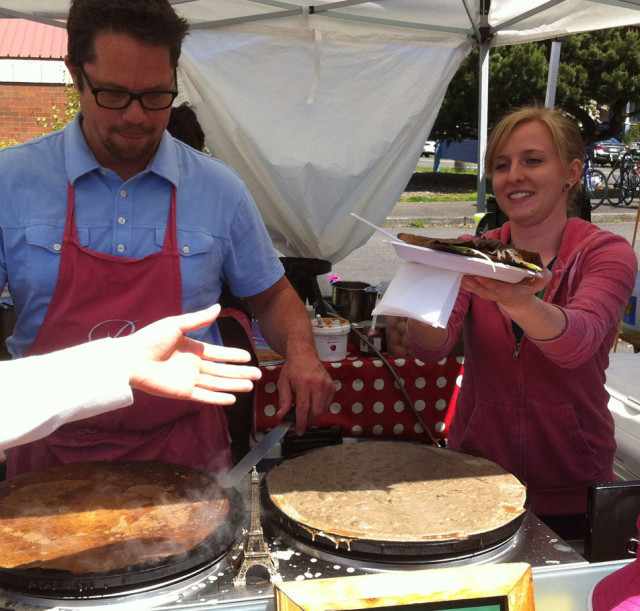Crepe-licious

These are the elements of a crepe: a hand to receive it, a hand to give it, and hands making more crepes on the pan.
Every culture has its hand pies, those holdable concoctions of flour folded around a mixture of vegetables, meats and cheeses; perhaps the French version, the crepe , is a touch more sophisticated than some others. But really, a crepe is easier to make than most hand-held nutrition-providing devices.
I’ve yet to try to make a British style pastie, for instance; instead I frequent Saraveza for the addictive Wisconsin tavern version. But a crepe is simple – and it’s a great way to wrap up and disguise healthy vegetables from the farmers market and tell the kids (truthfully) they’re eating pancakes.
Just about anything fresh and cooked well enough to be tender will be a winner inside a crepe, so choose whatever looks best at the farmers market that day. You may be tempted to let the market’s crepe-maker do the work if such a service is available, as it was this past weekend at the opening day of the King Farmers Market. But let the professional crepe maestros be your inspiration.
Recipes for crepe batter vary; pancakes are a notably forgiving food item. They’re basically flour, milk and eggs. The higher the milk to flour ratio is, the thinner and more delicate the pancake will be. As befits anything French, the crepe is the thinnest batter of all. Adding butter or sugar gives the batter more body and sweetness. Buckwheat or chickpea flours can be used to up the ante on the savory side (and provide a gluten-free option, though often the buckwheat combines with a bit of all-purpose flour, as in the recipe below).
Prepare the crepes in multiples and let folks fill and fold their own, with sautéed vegetables, grated cheeses and thinly sliced ham or smoked salmon laid out and added to order. A quick turn of the folded, filled crepe on a lightly buttered griddle can be a decadent final touch, letting the envelope warm around its contents.
Here’s a buckwheat crepe recipe to try, from our reliable kitchen friend, Mark Bittman, in his The Best Recipes of the World. And just so you know, buckwheat crepes are officially known as galettes – in contrast to actual crepes, which are made with wheat flour. Leave it to the French to have two words for pancakes! And to really blow your mind: did you know that buckwheat isn’t a wheat grain at all? It’s a relative of rhubarb!
Buckwheat Crepes
- ¼ cup all-purpose flour
- 1 cup buckwheat flour
- 2 eggs
- ½ cup milk
- Butter or neutral oil, like corn or grapeseed, for frying
Combine the first 4 ingredients in a bowl with 1 cup water; whisk until smooth and let sit for at least an hour if time allows [don’t worry if it doesn’t]
Heat an 8- or 10-inch nonstick skillet over high heat for about 2 minutes. Add a teaspoon or two of butter or a thin layer of oil, then pour most of it out (you can use it for the next crepe), leaving just a trace behind.
Pour in ¼ cup of the batter and swirl it around so that it coats the bottom of the pan completely; pour the excess back into the remaining batter. Adjust the heat so that the batter dries on top before it burns on the bottom; it will be ready to turn in 1 to 2 minutes. Turn and cook the second side for about 30 seconds. Repeat with the remaining batter, adding more oil to the pan if necessary (it will not always be). Stack the crepes as they finish, then fill as desired and serve.




